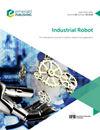基于模型的完整移动机器人车轮滑移和执行机构故障检测与隔离
IF 2.5
4区 计算机科学
Q3 ENGINEERING, INDUSTRIAL
Industrial Robot-The International Journal of Robotics Research and Application
Pub Date : 2022-05-17
DOI:10.1108/ir-01-2022-0001
引用次数: 1
摘要
目的:移动机器人可以在困难的操作条件下执行非常关键的任务。在执行任务过程中遇到故障,可能导致任务中断或完全失败。在主动容错控制方法中,不仅要检测机器人发生的故障,而且要隔离这些故障,从而制定适合于特定类型故障的故障恢复策略。本研究旨在开发一种基于模型的故障检测和隔离方法,用于轮式移动机器人可能发生的轮滑和电机性能下降。设计/方法/途径在提出的方法中,可以通过移动机器人的动力学模型来估计车轮速度,其中包括车轮与地面之间的摩擦模型。从移动机器人的估计状态和测量状态的差中得到4个残差信号。利用这些信号检测移动机器人的故障。采用两种不同的方法计算牵引力,产生两种不同的残余信号。然后用这六个残余信号来隔离可能的车轮打滑和电机性能下降。通过机器人在不同方向上的移动,对所提出的诊断车轮打滑和电机性能退化的方法进行了测试。根据从测试结果中获得的数据,创建一个逻辑表来将这两个故障相互隔离。由于创建的逻辑表,可以检测和隔离任何车轮的打滑和任何电机的性能下降。独创性/价值需要两种不同的恢复策略来恢复暂时的车轮打滑和永久性的电机故障。因此,在机器人的一般运动中,隔离这两种产生类似症状的故障是很重要的。通过本文提出的方法,不仅可以将滑动轮相对于非滑动轮隔离开来,或者将故障电机与非故障电机隔离开来,还可以将这两种不同的故障类型相互隔离开来。本文章由计算机程序翻译,如有差异,请以英文原文为准。
Model-based detection and isolation of the wheel slippage and actuator faults of a holonomic mobile robot
Purpose
Mobile robots may perform very critical tasks under difficult operating conditions. Faults encountered during their tasks may cause the task to be interrupted or failed completely. In the active fault tolerant control methods, it is very important not only to detect the faults that occur in the robot, but also to isolate these faults to develop a fault recovery strategy that is suitable for that specific type of fault. This study aims to develop a model-based fault detection and isolation method for wheel slippage and motor performance degradation that may occur in wheeled mobile robots.
Design/methodology/approach
In the proposed method, wheel speeds can be estimated via the dynamic model of the mobile robot, which includes a friction model between the wheel and the ground. Four residual signals are obtained from the differences between the estimated states and the measured states of the mobile robot. Mobile robot’s faults are detected by using these signals. Also, two different residual signals are generated from the calculation of the traction forces with two different procedures. These six residual signals are then used to isolate possible wheel slippage and performance degradation in a motor.
Findings
The proposed method for diagnosing wheel slip and performance degradation in motors are tested by moving the robot in various directions. According to the data obtained from the test results, a logic table is created to isolate these two faults from each other. Thanks to the created logic table, slippage in any wheel and performance degradation in any motor can be detected and isolated.
Originality/value
Two different recovery strategies are needed to recover temporary wheel slippage and permanent motor faults. Therefore, it is important to isolate these two faults that create similar symptoms in robot’s general movement. Thanks to the method proposed in this study, it is not only possible to isolate the slipping wheel with respect to the non-slipping wheels or to isolate the faulty motor from the non-faulty ones, but also to isolate these two different fault types from each other.
求助全文
通过发布文献求助,成功后即可免费获取论文全文。
去求助
来源期刊
CiteScore
4.50
自引率
16.70%
发文量
86
审稿时长
5.7 months
期刊介绍:
Industrial Robot publishes peer reviewed research articles, technology reviews and specially commissioned case studies. Each issue includes high quality content covering all aspects of robotic technology, and reflecting the most interesting and strategically important research and development activities from around the world.
The journal’s policy of not publishing work that has only been tested in simulation means that only the very best and most practical research articles are included. This ensures that the material that is published has real relevance and value for commercial manufacturing and research organizations. Industrial Robot''s coverage includes, but is not restricted to:
Automatic assembly
Flexible manufacturing
Programming optimisation
Simulation and offline programming
Service robots
Autonomous robots
Swarm intelligence
Humanoid robots
Prosthetics and exoskeletons
Machine intelligence
Military robots
Underwater and aerial robots
Cooperative robots
Flexible grippers and tactile sensing
Robot vision
Teleoperation
Mobile robots
Search and rescue robots
Robot welding
Collision avoidance
Robotic machining
Surgical robots
Call for Papers 2020
AI for Autonomous Unmanned Systems
Agricultural Robot
Brain-Computer Interfaces for Human-Robot Interaction
Cooperative Robots
Robots for Environmental Monitoring
Rehabilitation Robots
Wearable Robotics/Exoskeletons.

 求助内容:
求助内容: 应助结果提醒方式:
应助结果提醒方式:


